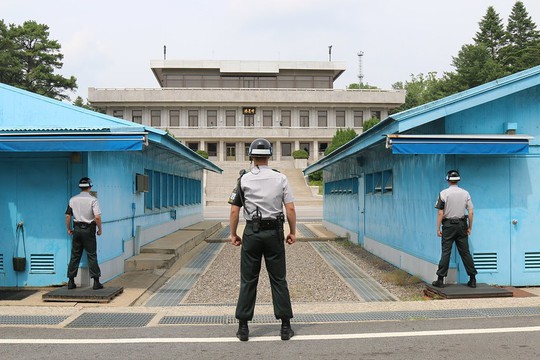Border point between the two Koreas.
On August 22, the U.S. State Department renewed its ban on the use of U.S. passports for travel to North Korea. This travel ban prohibits as many as 100,000 Korean Americans living in the United States from visiting their relatives in North Korea. The ban was first set in place by the Trump administration in 2017, and — in spite of Korean American activists’ repeated calls to lift the draconian ban — has been renewed annually since, ‘Asia Times’ writes.
During his presidential campaign in 2020, Joe Biden had promised to “reunite Korean Americans separated from loved ones in North Korea for decades,” but has extended the travel ban each year he has been in office. This current ban will remain in place until August 31, 2024, at which point it will either be lifted or extended again.
Kate Youngjoo Shim, an activist with the women’s peace organization ‘Korea Peace Now!’, is one of the many Korean Americans the travel ban impacts. Born in Korea, Shim moved to the U.S. at the age of 15. Both sides of her family are originally from North Korea, and the ban now prevents her from visiting cousins and other close relatives there.
Shim pointed out the hypocrisy of the U.S. government lecturing North Korea on human rights while keeping so many Korean family members separated.
“The biggest human rights violation to me is not letting people see their family,” said Shim. “The U.S. government is always trying to say things about [North Korea’s] human rights conditions, but if you’re not letting people meet their mothers, their children, their immediate families… there’s no excuse.”
And it’s not only Korean Americans barred from visiting family members in North Korea — the travel ban prohibits any U.S. passport holder from traveling there, effectively prohibiting any kind of cultural exchange between American citizens and Koreans in the North. These exchanges are essential to challenging the U.S. propaganda campaign that dehumanizes North Koreans in order to justify sanctions.
Gloria La Riva, an organizer with the ANSWER (Act Now to Stop War and End Racism) Coalition, called her travels to the North in 1989 and 2015 “life-changing experiences.”
“I saw people and a country that is the opposite of the hysterical, demonizing images we see in the West,” La Riva recalled. “I met people who were thoughtful and kind to visitors. That is what struck me most of all. When we boarded a full train, people immediately offered us their seats, smiling — the best language of all.”
…It was the U.S. that divided Korea along the 38th parallel in 1945 and separated millions of families, occupied the South, and dropped more than 600,000 tons of bombs over the peninsula during the Korean War. So extensive was the bombing campaign that U.S. pilots even ran out of targets and would drop bombs into the sea to safely land. Over the course of the war, the U.S. military leveled “nearly 90 percent of major cities and villages in North Korea,” killing a staggering 20 percent of its population.
 General Douglas MacArthur, UN Command CiC (seated), observes the naval shelling of Incheon from USS Mount McKinley, 15 September 1950.
General Douglas MacArthur, UN Command CiC (seated), observes the naval shelling of Incheon from USS Mount McKinley, 15 September 1950.
On top of the murderous carpet bombing campaign, the entire Korean War itself was punctuated by U.S.-backed atrocities: the murder of more than 100,000 people during the Bodo League massacre in 1950, which was committed by the government forces of U.S.-installed President of South Korea Syngman Rhee; the Sinchon massacre in which the U.S. military and South Korean anti-communist forces killed more than 30,000 civilians; the No Gun Ri massacre where U.S. military forces opened fire on civilian refugees, killing around 300 people. Taken altogether, U.S. involvement in the Korean War was nothing short of genocidal.
While the signing of the 1953 Armistice Agreement brought an end to the fighting, it did not bring an end to the conflict. The U.S. refuses to sign a peace treaty, and it, along with the South, remains suspended in an official state of war with the North. And even after the signing of the armistice, the U.S. government maintains a heavy military presence in Korea and continues to ratchet up tensions between the North and the South. South Korea remains under occupation: it’s home to the largest U.S. overseas base, and a total of 28,500 U.S. military personnel are stationed in the country. South Korea also hosts the annual Ulchi Freedom Shield joint military exercises with the U.S.
In 2006, the U.S. government, along with the United Nations Security Council, have relied on a brutal sanctions regime to punish North Korea for defying U.S. imperialism. These sanctions have caused food insecurity, malnutrition, and medical supply shortages in the country, leading to enormous suffering and thousands of preventable deaths.
The travel ban for the U.S., then, is another weapon of war, part of its broader strategy to further isolate North Korea and inflame tensions between both halves of the peninsula. And with Washington forging stronger military ties with Australia, the Philippines, and other countries in the “Indo-Pacific,” as well as increasing its militarization of the South China Sea, the Pentagon’s ultimate goal is to secure South Korea as an ally in its road toward major power conflict in Asia.
This path that Washington is leading North and South Korea down will only lead to more war and devastation for the Korean people. The U.S. government has never been interested in peace for the Korean peninsula. For more than 70 years, it’s done everything in its power to divide North and South, obstruct any and every path to lasting peace, and turn Koreans against each other, stresses Asia Times.
read more in our Telegram-channel https://t.me/The_International_Affairs

 12:05 11.09.2023 •
12:05 11.09.2023 •























